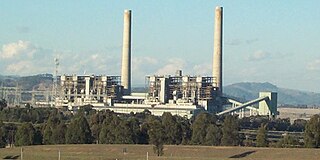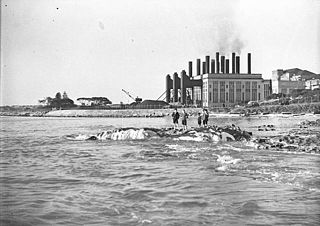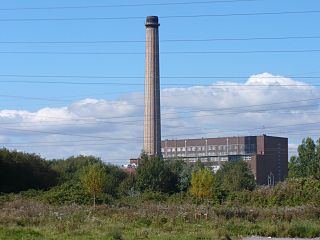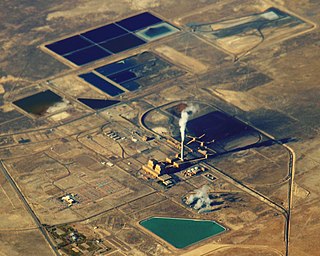
A power station, also referred to as a power plant and sometimes generating station or generating plant, is an industrial facility for the generation of electric power. Power stations are generally connected to an electrical grid.

A fossil fuel power station is a thermal power station which burns a fossil fuel, such as coal or natural gas, to produce electricity. Fossil fuel power stations have machinery to convert the heat energy of combustion into mechanical energy, which then operates an electrical generator. The prime mover may be a steam turbine, a gas turbine or, in small plants, a reciprocating gas engine. All plants use the energy extracted from the expansion of a hot gas, either steam or combustion gases. Although different energy conversion methods exist, all thermal power station conversion methods have their efficiency limited by the Carnot efficiency and therefore produce waste heat.

Origin Energy an ASX listed public company with headquarters in Sydney. It is a major integrated electricity generator, and electricity and natural gas retailer. It operates Eraring Power Station, Australia’s largest coal-fired power station, in New South Wales, which it plans to close in 2025. In 2022, it was Australia's fourth largest climate polluter. It has entered into a binding agreement to be bought by Brookfield Renewable Partners, and others, who plan to invest $30 billion dollars to assist its transition to renewable energy.

The White Bay Power Station is a heritage listed former coal-fired power station on a 38,000 m2 (410,000 sq ft) site in White Bay, in the suburb of Rozelle, 3 km (2 mi) from Sydney in New South Wales, Australia.

Ballylumford power station "C" station is a natural-gas-fired power station in County Antrim, Northern Ireland, UK. With its main plant generating 600 megawatts of electricity, it is Northern Ireland's largest power station and provides half its power. Overall the station produces 600 MW. The plant is located at the tip of the Islandmagee peninsula, which separates Larne Lough from the Irish Sea. The lough is a Site of Special Scientific Interest. The 3 chimneys of the now decommissioned "B" station are 126 metres tall. East of the station is the Ballycronan More converter station, the Northern Ireland end of the Moyle Interconnector, a subsea HVDC interconnector connecting the NI electricity system to Great Britain.

Munmorah Power Station is a demolished coal-fired power station with four 350 MW English Electric steam driven turbo-alternators for a combined capacity of 1,400 MW. The station was located near Doyalson, on the shores of Lake Munmorah, New South Wales, Australia and was owned and operated by Delta Electricity, a company owned by the New South Wales Government.

Vales Point Power Station is one of two operating coal fired power stations on the shores of Lake Macquarie, New South Wales. Vales Point is located on the southern shore of the lake, near the township of Mannering Park. It has two steam turbines, with a total generating capacity of 1,320 MW (1,770,000 hp) of electricity.

Liddell Power Station is a decommissioned coal-fired thermal power station that had four 500 megawatts (670,000 hp) EE steam-driven turbine alternators, providing a combined electrical capacity of 2,000 megawatts (2,700,000 hp).

Bayswater Power Station is a bituminous (black) coal-powered thermal power station with four 660 megawatts (890,000 hp) Tokyo Shibaura Electric (Japan) steam driven turbo alternators for a combined capacity of 2,640 megawatts (3,540,000 hp). Commissioned between 1985 and 1986, the station is located 16 kilometres (10 mi) from Muswellbrook, and 28 km (17 mi) from Singleton in the Hunter Region of New South Wales, Australia.

Wallerawang Power Station was a thermal coal power station, located near Wallerawang, in the Central Tablelands region of New South Wales, Australia. The power station was equipped with two turbo-alternators of 500 megawatts (670,000 hp) each, supplied by CA Parsons and Company of Newcastle-upon-Tyne, England. Production commenced in May 1957.
Collinsville Power Station is located in Collinsville, Whitsunday Region, Queensland, Australia. It had five coal powered steam turbines with a combined generation capacity of 190 MW of electricity. The coal-fired power station closed in 2013. A solar power farm generating 42MW has been built on adjacent land.

The Huntly Power Station is the largest thermal power station in New Zealand and is located in the town of Huntly in the Waikato. It is operated by Genesis Energy Limited, a publicly listed company. The station has five operational generating units – three 250 MW coal-and-gas-fired steam turbine units, a 50 MW gas peaking plant, and a 403 MW combined cycle gas turbine plant. The station also plays an important role in voltage support for the Northland, Auckland and Waikato regions.

AGL Energy Ltd is an Australian listed public company involved in both the generation and retailing of electricity and gas for residential and commercial use. AGL is Australia's largest electricity generator, and the nation's largest carbon emitter. In 2022, 83% of its energy came from burning coal. It produces more emissions as a single company than the nations of New Zealand, Portugal or Sweden, according to its largest shareholder, Mike Cannon-Brookes, who named it "one of the most toxic companies on the planet".

Wangi Power Station is a heritage-listed former coal-fired power station at Wangi Wangi, City of Lake Macquarie, New South Wales on Lake Macquarie. The power station operated between 1956 and 1986 and supplied electricity to New South Wales. It was once the largest in the state. The 12,000 square-metre building was listed on the New South Wales State Heritage Register on 2 April 1999.

The Newport Power Station was a complex of power stations located on the west bank of the Yarra River, approximately 6 km south-west of Melbourne, Victoria, Australia, in the suburb of Newport. Newport A, B, and C were coal-fired plants which operated at the site between 1919 and the 1980s, and were claimed to be the largest power station in the southern hemisphere in 1953 with 42 boilers and 14 turbo-alternators producing 327 megawatts (439,000 hp).
Cockle Creek Power Station was located in Teralba, New South Wales, Australia on the banks of Cockle Creek. The power stationed operated from 11 March 1927 until March 1976.

Bunnerong Power Station was a coal-fired power station in the south-eastern Sydney suburb of Matraville, New South Wales, Australia that was decommissioned by 1975 and subsequently demolished. When the last generating units were commissioned, it was the largest power station in the southern hemisphere, with a capacity of 375 megawatts (MW) from eleven turbo-alternators. It was able to supply up to one third of the state's electricity needs at the time. It remained the most powerful until the completion of Vales Point Power Station in 1966.

The Uskmouth power stations refers to a series of two coal-fired power stations at the mouth of the River Usk in the south-east of Newport, Wales. The first of the two station, Uskmouth A power station, was built in the 1940s and demolished in 2002.

Intermountain Power Plant is a large coal-fired power plant at Delta, Utah, US. It has an installed capacity of 1,900 MW, is owned by the Intermountain Power Agency, and is operated by the Los Angeles Department of Water and Power. The plant includes a HVDC converter. It is scheduled in 2025 for replacement with an 840 MW natural gas plant, designed to also burn "green hydrogen."



















